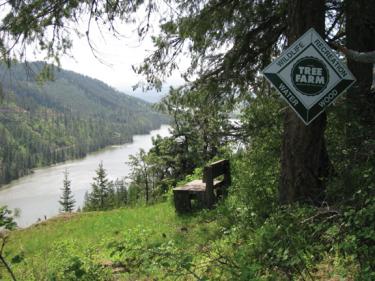Find Your Certification Program
Although there are a handful of certification programs to choose from, surprisingly few are suitable for private woodland owners. It’s unfortunate, but many programs seem designed for very large or corporate-owned forests.
Yet the nation’s oldest certification program happens to be specially designed for private woodland owners, and it’s also the most trusted name in family forest certification in the U.S. It’s the American Tree Farm System (ATFS).
ATFS is a program of the American Forest Foundation, which also launched MyLandPlan.org. It has been working with landowners on the good stewardship of their woods since 1941, and has grown over the past 71 years into a network of more than 89,000 woodland owners sustainably managing 27 million acres of forest.
To join ATFS, you have to meet eight standards of sustainability. You must:
- Commit to practicing sustainable forestry. That means developing a written management plan that addresses protection of forest health, soil, water, wood and fiber production, threatened and endangered species, special sites, and high conservation value forests.
- Comply with the law. You must follow all the relevant federal, state, county and municipal laws and ordinances when managing your woods.
- Reforest and afforest. You must replant harvested or damaged parts of your land with a tree species that’s appropriate for the site and for your objectives.
- Protect your air, water and soil. That means meeting or exceeding state forestry best management practices, using integrative pest management and only EPA-approved pesticides, and other practices.
- Protect your fish, wildlife and biodiversity. You must make sure your woods provide healthy habitat for threatened and endangered species and any other desired plant or animal species.
- Keep it beautiful. You must manage the visual impact of your management activities, so your forest is still aesthetically appealing. This could mean leaving an island of trees in place to hide a harvest area or log truck-loading zone from view.
- Protect your special sites. You must make a reasonable effort to find and maintain any sites on your property that have special historical, archaeological, cultural, geological, biological or ecological value.
- Conduct harvests and other management activities according to your plan. This means keeping all the values of your woods in mind when you undertake a harvest or other management activity, so your land stays as healthy as it can be. It also means using only qualified natural resource professionals and contractors who are licensed, experienced and follow all the necessary safety and fair labor rules.
Any private woodland owner with 10 to 20,000 contiguous acres can qualify, as long as he or she meets these standards. In return, ATFS certification provides woodland owners with increased access to the marketplace for forest products and a wealth of helpful resources. When you become certified by ATFS, you also become part of a community of woodland owners that are committed to sustainable woodland management. Many woodland owners enjoy the opportunity to talk with and learn from peers who share their values.
Other certification programs include
Sustainable Forestry Initiative (SFI) – Started in 1994, it includes 14 core principles, 20 objectives, 38 performance measures and 115 indicators that landowners must meet. Learn more here.
Programme for the Endorsement of Forest Certification (PEFC) – Started in 1999, it certifies the certifiers, including ATFS and SFI. Learn more here.
Forest Stewardship Council (FSC) – Started in 1993, it features 10 principles and 57 criteria landowners must meet. Learn more here.
Once you’ve chosen the right certification program for your woods, you’ll need to go through the process of getting certified. It’s a little different for each program, but a few things are the same—and good to know—regardless of your choice.
How can I get more tips?
It’s simple! Enter your email below.

